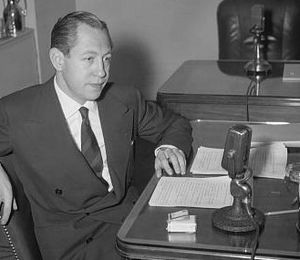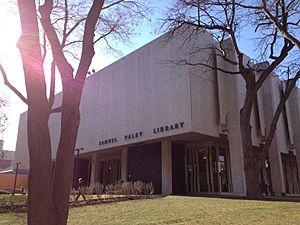William S. Paley facts for kids
Quick facts for kids
William S. Paley
|
|
|---|---|

New York, 1939
|
|
| Born |
William Samuel Paley
September 28, 1901 |
| Died | October 26, 1990 (aged 89) New York City, U.S.
|
| Resting place | Memorial Cemetery of Saint John's Church |
| Alma mater | University of Pennsylvania |
| Occupation | Television executive |
| Known for | President of CBS |
| Political party | Republican |
| Spouse(s) |
Dorothy Hart Hearst
(m. 1932; div. 1947) |
| Children | 4 |
| Awards | Carlos Manuel de Cespedes National Order of Merit of Cuba |
William Samuel Paley (September 28, 1901 – October 26, 1990) was an American businessman. He is best known for building the Columbia Broadcasting System (CBS). He transformed CBS from a small radio network into a major radio and television network in the United States. Paley received an award from the Cuban government for helping to improve understanding between the people of Cuba and the U.S.
Contents
Paley's Early Life and Education
William Paley was born in Chicago, Illinois, in 1901. His father, Samuel Paley, was an immigrant from Ukraine who owned a very successful cigar company. The family became wealthy and moved to Philadelphia in the early 1920s.
William went to Western Military Academy and then studied at the Wharton School at the University of Pennsylvania. His family expected him to join their cigar business.
Starting the CBS Network
In 1927, William's father and some partners bought a small radio network. It had 16 stations and was called the Columbia Phonographic Broadcasting System. Samuel Paley wanted to use it to advertise his cigar brand, La Palina.
William took charge of the network. Within a year, cigar sales more than doubled! By 1928, the Paley family owned most of the network. In just ten years, William S. Paley grew the network to 114 stations.
How Paley Revolutionized Broadcasting
William Paley quickly understood how much money radio could make. He realized that great shows were key to selling advertising time. This brought in profits for the network and its local stations.
Before Paley, most people saw radio stations as local businesses, like local newspapers. Stations used to buy shows from the network. Paley changed this business idea.
Making Advertising Profitable
Paley created popular and profitable shows. He also saw that advertisers were the most important part of the broadcasting business. He offered network shows to local stations for a very low cost. This made sure that many people could hear both the shows and the advertisements.
Advertisers then became the network's main customers. Because the network was growing and reaching more people, Paley could charge more for ad time. Local stations had to broadcast network shows for part of the day. They also got a share of the money from network advertising. At other times, stations could air their own local shows and sell local ads.
Building a Media Empire
Paley's understanding of how to use radio's wide reach was key. It helped him grow CBS from a small group of stations into a huge communication company. People said Paley had a special talent for knowing what the public liked. He used this skill to build the CBS network.
As World War II approached in the late 1930s, Paley knew Americans wanted news about the war. He built the CBS news division into a powerful force. He had done the same thing earlier with the network's entertainment shows.
CBS During World War II
By 1940, Paley imagined a CBS division for South America. With his news director Paul White and shortwave director Edmund Chester, Paley started a network of 64 stations in 18 countries. It was called La Cadena de las Americas (The Network of the Americas).
By 1942, this network broadcast news and cultural programs live from New York City. It worked with the U.S. government's Office of the Coordinator of Inter-American Affairs. These broadcasts helped promote cultural understanding during World War II. Paley and Chester received Cuba's highest civilian honor for their efforts.
During the war, Paley also worked for the U.S. government in London. He was a colonel in the Office of War Information. While in England, Paley became friends with Edward R. Murrow, CBS's head of European news. Murrow expanded CBS's war coverage with a team of reporters known as the Murrow Boys.
Expanding into Television
In 1946, Paley made Frank Stanton the president of CBS. CBS then expanded into TV. It grew quickly after the war and became bigger than NBC, which had been the leader in radio.
CBS owned the Columbia Record Company and its CBS Laboratories. In 1948, Columbia Records introduced the 33-1/3-rpm LP record. This record could hold over 20 minutes of music per side and became a standard for many years.
CBS Laboratories also developed a way to create color television. However, the Federal Communications Commission (FCC) later chose a different color TV system developed by RCA. CBS sold its color TV patents to other countries. The PAL (Phase Alternating Line) system, which CBS helped develop, is still used in many parts of the world today.
Paley's Impact on CBS Shows
60 Minutes creator Don Hewitt said that Paley built "two towers of power: one for entertainment and one for news." He added that Paley was the person who put Frank Sinatra and Edward R. Murrow on the radio and 60 Minutes on television.
Paley and his news staff sometimes had disagreements. His friendship with Edward R. Murrow became difficult in the 1950s. This was because of the strong, direct style of Murrow's show, See It Now. Some sponsors were worried about the show's controversial topics. Paley worried about losing money and facing scrutiny during the time of McCarthyism. The show eventually stopped its weekly broadcasts in 1955.
In 1959, James T. Aubrey Jr. became president of CBS. Under Aubrey, CBS became the most popular TV network with shows like The Beverly Hillbillies and Gilligan's Island. However, Paley's personal favorite show was Gunsmoke. In 1967, when Gunsmoke was about to be canceled, Paley demanded it stay on air. This led to Gilligan's Island being canceled instead, even though it had been renewed.

In 1972, Paley ordered a part of a CBS Evening News series on the Watergate scandal to be shortened. This happened after a complaint from an aide to President Richard Nixon. Later, Paley briefly stopped CBS news commentators from giving instant, critical opinions after presidential speeches.
Over the years, Paley sold parts of his family's CBS stock. When he died, he owned less than nine percent of the company. Years after Paley's death, CBS was bought by other companies. Today, CBS is part of Paramount Global.
Paley's Other Interests
William Paley had many interests outside of broadcasting. He collected modern art and owned many important artworks. He also enjoyed photography.
In 1964, CBS bought the New York Yankees baseball team. The team did not do well for ten years. In 1973, Paley sold the team for $8.7 million.

Philanthropy and Art
Paley loved modern art, and his collection was amazing. The Museum of Modern Art made him a trustee in the 1930s. In 1962, he became its president. He later became chairman, stepping down in 1985.
In 1974, Paley helped open a new building at Syracuse University. He also dedicated the Samuel L. Paley library at Temple University, named after his father.
In 1976, Paley founded The Paley Center for Media in New York City. It was first called the Museum of Broadcasting. It collects and preserves television and radio programs.
Paley's Personal Life
Marriages and Family
Paley married Dorothy Hart Hearst in 1932. She helped him meet important people in President Franklin Roosevelt's government. They divorced in 1947 and had two adopted children, Jeffrey and Hilary.
Paley then married Barbara "Babe" Cushing Mortimer in 1947. She was a well-known socialite and fashion icon. William and Babe Paley built a summer home in New Hampshire. They often entertained many famous friends there, including Lucille Ball and Grace Kelly. They had two children, William and Kate.
Death
William Paley passed away on October 26, 1990, at the age of 89. He was buried in New York.
Works by William Paley
- As It Happened: A Memoir (1979)
Awards and Honors
- Croix de Guerre with Palm, 1946
- Legion of Honor
- Legion of Merit, 1946
- Peabody Award, 1958 and 1961
- Inducted into the Junior Achievement U.S. Business Hall of Fame, 1984
- Inducted into the Television Hall of Fame, 1984
- Walter Cronkite Award for Excellence in Journalism, 1984
- Carlos Manuel de Cespedes National Order of Merit by the Cuban government
See also

